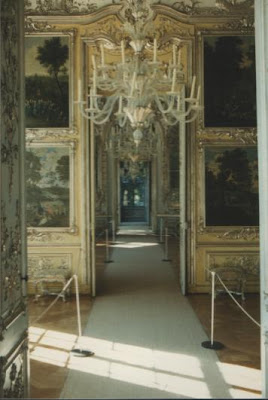As previewed in the previous posting, this one is looking at alternate London Underground maps. I have featured some like 'The Great Bear' and the Gallifrey one in August 2007. This posting has some more including a more thorough German translation one rather than the semi-English/semi-German one I have shown before, though I like the counter-factual implications of that one.
This is the one that got me started, a postcard from the city of Bath in western England. Given that the city is over 2000 years old, it seems odd that they portray it in this modern way. This postcard makes it seem a lot larger than it actually is. It is a very picturesque place with Georgian architecture and extensive Roman remains. One could easily envisage a Bath Below given how much stuff is buried there going back so many centuries. Maybe Neil Gaiman will consider it.
City of Bath 'Underground' Map
I have removed this image as a result of a copyright challenge.
Having seen this, I wondered if other cities had done the same. There were a few from US cities but nothing which leapt out and instead I began encountering the underground map used in different ways. Before progressing, I will show the earliest version from Henry Beck in 1931 which actually shows how much it has progressed. The style today actually looks more 1960s with 1980s overtones than anything from the 1930s despite the emphasis on continuity.
London Underground Map by Henry Beck
This one was designed for a book called 'Transit Maps of the World' (2007) by Mike Oveden and gives some indications of airline links across the world.
To some extent it is rather like those maps which show contries by the magnitude of something that they are involved in such as consumption of electricity and you see that Spain and Portugal for example are portrayed about a third of the size of the whole of Africa and similarly the Middle East is extended, in both cases reflecting the amount of airline traffic iin comparison to the geographical sizes of these regions
London Underground Map in German
This is the promised one more properly rendering the stations into German. Though this then makes it appear more like just a tourist tool than the implications of a collaborationist regime in the style of 'SS-GB' or perhaps 'When William Came' suggested by the less thorough one I have shown before. I guess for all British people showing familiar things in German still has echoes because even the current generation often defines itself in reference to being opposed to anything German despite the fact that most grandparents were only children when the last war against Germany finished.
Now, I move away from the geographical to the intellectual. The London Underground styling is often used almost like a mindmap to illustrate in a somehow tangible way things which are really intangible. The simplest one I have found is this one which almost seems to be axes of taste in culture:
Understated Tube Mind-Map
This one is reminiscent of those maps that look like ones of fantasy worlds but in fact show groupings and developments on the internet. This one shows what are seen as current trends in global society and how they inter-relate to people. It has Chinese characters, which in itself can be seen as a trend, but may also hint at a source. It is interesting that whoever it came from is less imbued with the fantasy map background and clearly is more familiar with the portrayal of actual cities. Perhaps by adopting this style they felt it would gain more credibility than a fantasy-style map. Looking at it, it does not resemble the London Undeground map but one of the maps from other cities like the Paris Metro system or most likely a system in Beijing or Shanghai.
Trend Blend Urban Transport Style Map (2008)
The following one is similar but again focused purely on the internet and seems closer to the London Underground mapping. I do wonder if in 2008 that this style is seen as cool and serious compared to the fantasy world map style of the past few years that were used to illustrate such things.
Web Trend Map (2008)
Rather than go with one of the numerous music style maps which I know less about, though I may come back to them in the future, I was attracted to this one from the Royal Shakespeare Company. It is reminiscent of 'The Great Bear' and that might be indicated by the title they have adopted. It features Shakespeare characters and the mapping to some extent shows the relationships between them. I must say this is one of my favourites and it goes beyond the simply conceptual basis. I also like the little icons next to some of the 'stations' too. I would love it if the underground stations were labelled by Shakespeare characters. Given that the main point of access for millions of people each year to poetry is simply by the Poems On The Underground scheme which started in 1986 (it means poems are put up in advertising slots in underground train carriages), then why should not more of their journey be influenced by literature?
Greater Shakespeare Underground Map
This final one is just a comic one, substituting various foods ('grub' is an old UK slang term for food) for the underground stations. I do wonder why Transport For London went after the Geoff Marshall one and not this one which in my mind could appear more insulting, though in fact I feel they are all delightful and bring attention and respect to the London Underground system and its iconography.
Undergrub Map


















































